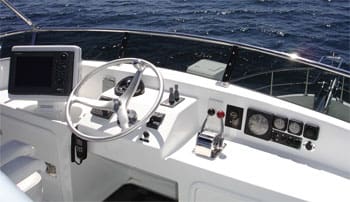The hydraulic steering installed on your power voyaging boat is one of the most reliable systems aboard. To “dial-in” your trawler steering there are some fundamentals you should understand and a few key components you should monitor as part of your regular maintenance routine; oil reservoir, hydraulic cylinder, hydraulic ram, tiller arm, oil manifold, rudder post, rudder bearings, etc.
Most sailboats can balance the helm through sail trim resulting in a light steering touch and the hull shape is designed to still hold course when heeled over. Trawlers have no such natural force to assist with directional guidance and trawler hull shapes are “boxier,” they run more upright and may have additional appendages dragging (like active fin stabilizers, skegs and fixed propellers) making trawler hull forms less “fluid” through the water.
Unless you’ve had a problem with your steering system, you may not have given this much thought, but naturally the ability to turn your trawler with a responsive helm is an essential attribute! Trawlers rely on the natural water flow (technically the turbulence of propeller wash) across the rudder(s) to maneuver.
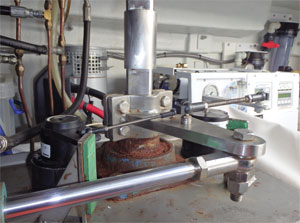 |
|
Rudder post with tiller attached to steering ram. Note padded rudder stops and two autopilot sensors. |
One of the first boat handling tricks many of us learn is to back-and-fill — hard over rudder and then a series of main engine gyrations shifting from forward to neutral to reverse — with a little throttle boost now and again — to get the hull rotating in a circular motion. Think of your rudder as a deflector and remember, unlike a car that turns via the front tires, you are really turning the stern to change course. When backing in reverse you may experience prop-walk to port or starboard. It’s a good idea to practice so you can anticipate your direction of travel. Bow and stern thrusters can be very helpful in close-quarter maneuvering, but for a trip outside of the harbor of any distance you really need the ability to steer straight and track on course using your rudder(s).
As you spin your steering wheel, (in the pilothouse or on the flybridge), the hydraulic gear pump sends pressurized hydraulic oil as a force in one direction or the other to actuate the ram housed in the steering cylinder. The ram, which acts like a piston that pushes or pulls, is attached to a stout horizontal tiller arm clamped on top of the vertical rudder shaft which correspondingly rotates the rudder(s) to port or starboard. Cylinders and rams are typically mounted horizontally on top of the rudder bearing support post. It is vitally important that the ram is not restricted by loose items in your lazarette that could shift while underway and interfere with this constant movement.
Air pressurized
Most of these steering systems utilize a hydraulic oil reservoir with small sight level “windows” to show how much oil is inside. They are air pressurized via a Schrader valve (bicycle inner tube type). The closed-loop system of hoses and valves is driven by the helm pump which sends the oil to move the ram.
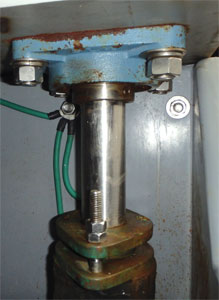 |
|
Rudder bearing mounted above, rudder tube coupling below. |
If your steering feels sluggish, the first place to look is the air pressure analog gauge on top of the reservoir. If the needle is below the normal settings, a few strokes with a simple bicycle pump (a tool you should have on board and keep near the reservoir) will help you regain the force you need to get back on track. Be sure to regularly (before leaving the dock) inspect the pressure gauge on top of the reservoir as air leaks are not uncommon.
Well designed steering systems include a hydraulic oil steering manifold near each rudder (single vs. twin) and this manifold will have a bypass valve so that you can disable the hydraulic oil loop and turn the rudder post head manually with your emergency tiller. The operational components (bypass valve, emergency tiller fitting, etc.), should be sourced, labeled and understood before you leave the dock. Using an emergency tiller will provide steering that is better than nothing (barely) so take a look at how your trawlers’ back-up steering system is designed. Consider a block and tackle apparatus to help you actually control and leverage the emergency tiller so that you will be able to turn your trawler if you get into difficulty. Actual hand steering using your emergency tiller can be very difficult and fatiguing, it may be wise to weld a ring on the tiller end for attaching lines.
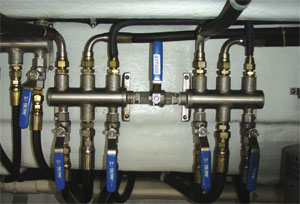 |
|
Steering manifold with bypass valve labeled. |
It is also possible to have a hydraulic oil leak. If so your reservoir oil will show a lower level, and the first place to look is the hydraulic cylinder and ram. Ram seals can get tired over time and weep oil. The hard and soft plumbing hoses used to route the hydraulic oil have connections and valves that can leak, so it’s a good idea to keep an eye on all of your hydraulic runs and look for tell-tale oil pools. Track down leaks looking for drips or puddles, make the fix and then use a small funnel and some correct weight steering oil (two more important tools to have aboard) to refill the reservoir. Then pump up the air pressure to the appropriate needle reading. You may need to purge air out of the entire system when you add oil. To do this you open your bypass valve and spin the steering wheel in one direction for 100 turns, then switch directions for another 100 turns before closing the bypass.
You also have several mounting connections that require regular inspection. Where the ram attaches to the rudder post tiller arm you will find a series of nuts and bolts, make sure all of the nuts are tight. Also check the fastener connections that clamp the tiller arm to the rudder post. The rudder bearing support bar and the stainless steel attachments that make up the rudder support box all have adjustable connections, be sure to check that all of them are properly tightened at the beginning of the season. When you know your fasteners are tight and secure you can make a simple straight line permanent ink mark to indicate separation if the fittings loosen, providing you a visual warning.
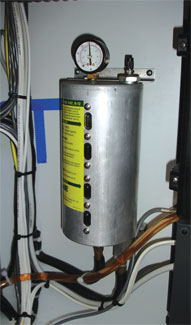 |
|
A steering oil reservoir equipped with an air pressure gauge and oil level windows. |
Most neglected through-hull
Probably the most neglected through-hull on any trawler is the rudder post (posts on a twin) where there is a vertical “shaft log” with an adjustable bronze coupling and stuffing box with flax packing (very similar to your main engine shaft through-hulls). These connections do not experience the type of wear and tear that the constant rotational friction a propeller shaft imposes on a stuffing box, but the rudder shaft logs are equally important. Regularly confirm that all of the connections that run the length of the rudder column up to the bearing in the rudder box are free from showing signs of wear and tear.
Familiarization with your trawler steering system’s working components, like greasing the rudder bearing, checking rudder stops (which prevent out-of-control hard over turns) and inspecting the upper and lower rudder connections during your next haul out will help ensure safer operations. You should also be familiar with your autopilot. You will most likely have different parameters for running into head seas vs. sliding along with following seas. There is also a direct interaction between your autopilot and your active fin stabilizers as the two different systems can “fight” for course control and you need to drill down into the pilot and fin menus to quickly optimize their settings for varying sea conditions.
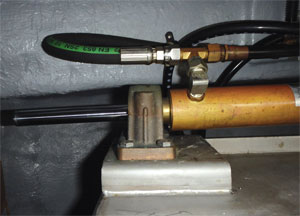 |
|
The steering ram cylinder needs a clear area to go through its full stroke. Make sure no loose items can fall into this space and block it. |
Count how many turns your hard over “lock-to-lock” is and practice getting back to a centered helm (you can verify with your autopilot rudder angle indicator). Steering your trawler involves a lot more than just turning the helm, take some time to learn how everything works and make sure you know the location of all of the components in your system to ensure you remain relatively trouble free and on the straight and narrow path to your next destination.
———–
Jeff Merrill, CPYB, is the president of Jeff Merrill Yacht Sales and a veteran yacht broker who provides individual attention and worldwide professional representation to buyers and sellers of premium brand, oceangoing trawlers. Merrill is active in the cruising community as a public speaker and writer and enjoys spending time at sea with clients. Merrill is constantly looking for new ideas to improve and simplify the trawler lifestyle. If you have a suggestion or want to get in touch please e-mail Merrill at: trawlerspecialist@gmail.com.

